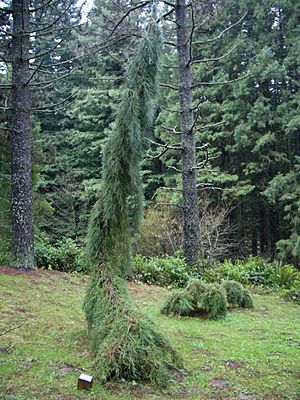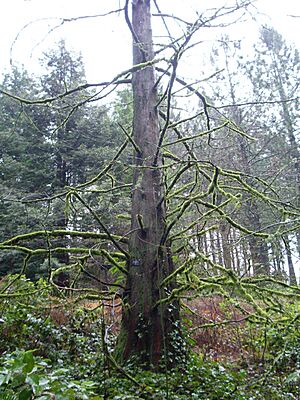Hoyt Arboretum facts for kids
Quick facts for kids Hoyt Arboretum |
|
|---|---|

Weeping Sequoia (Sequoiadendron giganteum 'Pendulum') in Hoyt Arboretum
|
|
| Lua error in Module:Location_map at line 420: attempt to index field 'wikibase' (a nil value). | |
| Type | Arboretum |
| Location | Portland, Oregon, United States |
| Area | 189-acre (76 ha) |
| Visitors | 350,000 |
| Status | Open to the public |
| Website | hoytarboretum.org |
The Hoyt Arboretum is a special place in Portland, Oregon, United States. It sits on top of a hill in the west part of the city. You can find it about two miles (3 km) west of downtown Portland.
The arboretum is inside Washington Park. It's also very close to the Oregon Zoo and the International Rose Test Garden. You can visit the arboretum easily from Washington Park. You can also get there from the Wildwood Trail, which connects to Forest Park.
Contents
History of Hoyt Arboretum
The Hoyt Arboretum is built on steep hills. These hills are above the Oregon Zoo and the Portland Japanese Garden. The arboretum's height ranges from about 650 feet to 900 feet. It also has several deep valleys.
This hilly land was once owned by private people. The United States government gave land to early American settlers. This was done through a law called the Donation Land Claim Act in 1850. People tried to farm and log the land, but it didn't work out. By 1865, Multnomah County owned the land.
In 1889, a big forest fire damaged the area. Part of this burned land was later used for a large farm. This farm was called the Multnomah County Poor Farm Hillside Farm. It was about 160 acres (64.75 hectares) in size.
After the Poor Farm closed, Multnomah County sold the land. The City of Portland bought it in 1922. The city then created Hoyt Arboretum in 1930. They asked John W. Duncan to design the new arboretum. He was the superintendent of parks in Spokane, Washington.
Duncan finished his plan in 1930. It showed where to plant nearly 40 types of trees. These trees were arranged to look natural. Workers from the Works Progress Administration helped clear the forest. They also built roads and paths in 1930 and 1931. Some native trees that grew after the 1889 fire were left in place.
Trees were planted following Duncan's plan from 1931 to 1944. Many trees had to be replaced after a big storm in 1962. The arboretum was started to protect rare trees. It also helps teach people about plants.
The arboretum has grown bigger over time. It now covers about 189 acres (76 ha). Around 350,000 people visit the arboretum each year.
Amazing Plant Collections

The arboretum is home to about 6,000 individual trees and shrubs. These plants belong to more than 2,300 different species. They come from all over the world. Sixty-three of these species are rare or in danger of disappearing.
Most plants have labels. These labels tell you their common name and scientific name. They also tell you where the plant originally came from.
The arboretum has a special collection of magnolia trees. This collection is known across the country.
It also has one of the largest collections of conifers in the United States. Conifers are trees that have needles and cones. This collection includes a dawn redwood. This tree is special because it's a conifer that loses its needles in winter. Most conifers stay green all year.
People once thought the dawn redwood was extinct. It was only known from old fossils. But in 1944, it was found again in a faraway valley in Hubei province, China. The tree was brought back to the Western world in 1948. Hoyt Arboretum was one of the first places to receive it. In 1952, the dawn redwood at Hoyt Arboretum made cones. This was the first time in about 6 million years for a dawn redwood in the Western world!
The arboretum also has a Winter Garden. This garden shows off plants that look colorful in winter.
In 2016, a new bamboo garden opened. It's called "the largest bamboo collection in the Pacific Northwest." It has over 30 types of bamboo plants.
What You Can Do and See
The arboretum has twelve miles (19 km) of trails. Two miles (3 km) of these trails are easy for wheelchairs. Over 250 signs and information panels mark the trails.
The Wildwood Trail and the Marquam Trail meet here. The Wildwood Trail goes north to Forest Park. The Marquam Trail goes south to Marquam Nature Park. Both trails are part of Portland's 40-Mile Loop trail system.
The visitor's center is in the middle of the park. It has a small nature center and a research library. Visitors can find information about the park and its trees here. The visitor's center is also where guided tours start. The research library has over 800 books about plants. Anyone can use it.
The Stevens Pavilion is a covered picnic area. It has a wooden roof and stone floors. It's tucked away among Douglas-fir trees.
Cool Art at the Arboretum
- House for Summer is a living sculpture. It's made of Himalayan birch trees. Artist Helen Lessick planted it in 1987. The sculpture looks like a forest shelter. It changes with the seasons. Park workers help take care of it.
- Basket of Air is a round sculpture. It's made of shiny steel. Portland artist Ivan McLean made it. It looks like a bamboo basket. The sculpture hangs over the pond in the bamboo garden. It was put there in 2016.
How to Visit
Parking at the Hoyt Arboretum costs money. It's $2 per hour, up to $8 per day. You can also get to the arboretum by bus. TriMet bus route 63-Washington Park stops there.
There's also a free Washington Park Shuttle. This shuttle connects the arboretum to the MAX light rail at the Washington Park station. The shuttle runs every day from April to October. From November to March, it runs only on weekends.
See also
 In Spanish: Hoyt Arboretum para niños
In Spanish: Hoyt Arboretum para niños

